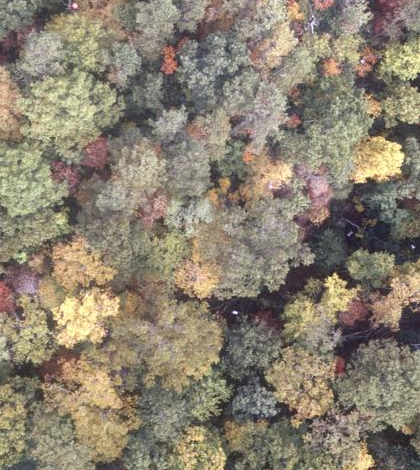Short-Term Droughts Can Mean Long-Term Struggle For Trees In Southeastern Forests

Trees in Southeastern forests may experience a shift in species due to more frequent droughts. (Credit: Duke University)
Researchers at Duke University have found that trees in Southeastern U.S. forests are dying slowly due to dehydration and other factors caused by droughts over many years.
The study is based on records of growth measurements of trees of all ages, sizes and species in the forests, particularly in North Carolina. The researchers tagged trees and monitored and recorded their growth rates for twenty years.
They were able to determine that the trees’ growth rates were largely affected by drought – periods lasting up to a month without precipitation – during growing seasons. They would shut down, shed leaves or dehydrate during these periods in order to survive.
“Growth is the first thing to go,” said Aaron Berdanier, lead author of the study and doctoral student in the school of Environment at Duke. “There are other priorities that need to be taken care of to maintain their condition. If a tree is growing less, that means it doesn’t have surplus energy to devote to getting bigger.”
According to Berdanier, trees are constantly losing water and taking in carbon to do photosynthesis. If they are not able to keep that up, then they will get dehydrated and their growth rates will reach a deficit.

It can take over ten years for a tree to die from drought implications. (Credit: Duke University)
Scientists used the Palmer Drought Severity Index to identify three periods in the 20-year study with severe drought. The most severe was between 2000 and 2002. What they found was that older trees seemed to stand the test of time a little longer than younger trees, up to ten years longer. They could recover better than smaller trees, possibly because of larger root systems and more storage for water and carbon reserves that smaller trees don’t have.
One of the many ways Berdanier said they could prevent death from happening is by getting rid of the competition.
“One nice thing about this taking up to a decade to happen is that you can intervene to make sure the tree doesn’t die,” said Berdanier. “You could give the tree more space, reducing competition for soil moisture. We found that trees that had lost more of their neighbors did a little bit better.”
Berdanier hopes to expand on the research by monitoring water-use patterns to see how water-use changes during drought. Some trees will shut down immediately, while others continue on, potentially at risk of dehydration. Researchers want to see how this relates to the growth rates and determine what other preventive measures can be taken to conserve the Southeastern forests.
Berdanier expects there will be some shifts in species composition and the ones that can withstand warmer climates will take over. But the biggest takeaway from this study is that forests are all equally vulnerable to drought. Whether they are in drylands like California, or humid, wet conditions in North Carolina, they are at just as much risk.
Top image: Trees in Southeastern forests may experience a shift in species due to more frequent droughts. (Credit: Duke University)




0 comments